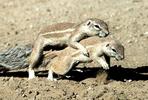
Name
Mountain Ground Squirrel [Xerus princeps]Appearance
The Mountain Ground Squirrel has previously been considered as a subspecies of the Cape Ground Squirrel, but has since been recognised as a species in its own right. It is also known as the Kaoko Ground Squirrel. It is larger than the Cape Ground Squirrel, and weighs 1.4 kg. Its tail and hindfeet are also longer than its sister species.
The upper parts of the body are bright fawn in colour, with a lateral white stripe on either side of the dorsum. White under parts, and the distinctive bushy tail shows three black black bands, unlike the two of the Cape Ground Squirrel.
The teeth appear orange in colour rather than white. The body hairs also appear finer than its closest relative.
Diet
High quality foods, like bulbs, roots and green sprouting plants, as well as Acacia seeds, are taken. At times they will scale two meter high into bushes in order to harvest green leaves, berries and mopane plant lice.Breeding
Give birth to an average of three young per litter after a gestation period of 48 days, normally during mid-summer although they may extend their breeding period into winter.Social Behaviour
Emerging from burrows well after sunrise, this species is diurnal. As an adaptive measure to its harsh environment, it only occurs in small groups, sometimes only in pairs. Single burrows are constructed amongst rocky outcrops.
These simple burrows, much less complicated than that of the Cape Ground Squirrel, have only one nesting chamber. Exploits home ranges of up to 40 hectares, in which they feed on vegetation.

